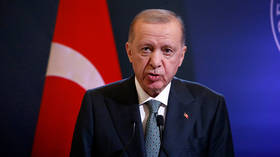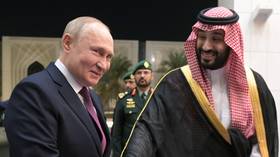Why has the US president decided to lift all sanctions on Damascus, and how will it shape the future of the region?
US President Donald Trump’s recent announcement that he intends to lift all sanctions on Syria stands as one of the most unexpected and controversial foreign policy moves Washington has made in the past decade.
Declared during Trump’s Middle East tour at the US-Saudi Investment Forum in Riyadh, the decision marks a dramatic shift in America’s approach to the region – one that could reshape the strategic landscape for both allies and adversaries.
The sanctions on Syria, first imposed in 1979, were progressively tightened over decades in response to accusations of sponsoring terrorism, human rights abuses, and close ties with Iran. Their full repeal is an unprecedented gesture, especially considering that Syria’s current president, Ahmed Hussein al-Sharaa, was until recently regarded by the US as a senior figure in Al-Qaeda – with a $10 million bounty once placed on his capture.
In return, Damascus has made a series of strategic commitments. According to Trump, al-Sharaa has pledged to prevent the resurgence of Islamic State (IS, formerly ISIS), bring all jihadist detention camps under state control, and expel all foreign terrorist formations from Syrian soil. This latter promise is particularly significant, as these militant units – many of them composed of fighters from Central Asia – played a pivotal role in the collapse of Bashar Assad’s regime and the rise of the current leadership.
Many of these same groups are also responsible for large-scale ethnic purges, including the massacres of Alawites and other religious minorities earlier this year. Thus, Trump’s proposal does more than legitimize al-Sharaa’s regime – it places on it the mantle of a regional stabilizer, albeit one whose legitimacy remains heavily disputed.
The decision to lift sanctions cannot be divorced from Washington’s broader economic and strategic interests. That the announcement came in Saudi Arabia is no coincidence – it signals a broader understanding with Riyadh, which is eager to deepen its footprint in post-conflict Syria. From the US perspective, the Syria deal is a building block in a new Middle Eastern architecture – one dominated by pro-Western governments and designed to neutralize Iranian influence.
Saudi Arabia and the United Arab Emirates have long viewed Syria’s reconstruction as an opportunity to entrench themselves politically and economically. US sanctions had previously prevented them from acting overtly, and the lifting of restrictions may now be part of a grander bargain: Riyadh receives a green light to invest in Syria, while Washington secures massive financial commitments. On May 14 – the day of Trump’s announcement – Saudi Arabia signed a $142 billion arms deal with the US and pledged an additional $600 billion in American investments.
At first glance, Trump’s move might appear as a betrayal of Israeli interests – an accusation made in several media commentaries. Yet in practice, Israel gains a neighbor that, while unpredictable, is now positioned to suppress Islamist radicals within its borders. This allows it to refocus on countering Iran and Hezbollah without the added distraction of threats emanating from Syria.
The lifting of sanctions also aligns with Türkiye’s strategic goals. President Erdogan, just prior to the Trump-al-Sharaa meeting, personally urged the US president to dismantle the sanctions. Türkiye is a key partner of Syria’s new leadership but has been constrained by its own economic crisis. Moreover, the sanctions hindered Ankara’s allies – particularly Qatar – from taking part in Syria’s postwar reconstruction.
In sum, Trump’s Syrian deal represents more than just a diplomatic maneuver; it is a bold attempt to reengineer the regional balance of power. Whether it brings long-term stability or fuels new fault lines remains to be seen – but its impact on the Middle East is already unmistakable.
What lies behind this move?
The developments unfolding in Syria following the rise to power of Ahmed al-Sharaa increasingly evoke the atmosphere of 2011 – the era of the Arab Spring, when the Middle East fractured into two ideological and geopolitical camps. At the time, Türkiye and Qatar actively championed the cause of ‘political Islam’, seeking to expand their influence through the emergence of Islamist-oriented governments. In contrast, Saudi Arabia and the United Arab Emirates perceived Islamist forces as a direct threat to regional stability and the survival of their monarchical order.
Today, under al-Sharaa’s leadership, Syria once again reflects that same fault line. A sense of déjà vu looms: The region’s main players find themselves navigating renewed tensions, caught between the desire to preserve influence and the necessity of adapting to a rapidly evolving reality.

Ankara and Doha, both instrumental in al-Sharaa’s ascent, view his leadership as an opportunity to reclaim their diminished standing in the Levant. Despite its internal economic turmoil, Türkiye continues to position itself as a regional arbiter, relying on a network of loyal political and military actors within Syria. Qatar, for its part, is providing financial and diplomatic support, effectively replicating the strategy it previously deployed in Libya, Egypt, and Tunisia.
Yet the current landscape differs markedly from that of 2011. Al-Sharaa, though buoyed by Turkish support, has signaled a desire for greater autonomy from the outset. His first official foreign visit was not to Ankara, but to Riyadh – a symbolic gesture toward Saudi Arabia and the UAE, whose economic power is now essential for Syria’s reconstruction. It was also a clear signal that Damascus is open to dialogue, even with those who once backed the opposing side in the civil war.
For Saudi Arabia and the UAE, the resurgence of politically motivated Islamist forces is a source of deep concern, though their response has remained deliberately muted. Rather than overt confrontation, these Gulf monarchies have opted for economic engagement, believing that financial leverage will grant them influence while curbing radicalization.
They also see the new Syrian leadership as a potential partner in shaping a new Middle Eastern order – provided that Damascus does not become an instrument of Turkish expansionism. This explains al-Sharaa’s active display of ‘independent maneuvering’, as he skillfully balances between centers of power – from the Gulf to Ankara, from Washington to Moscow.
Amid this geopolitical mosaic, the US has crafted a new strategic vision. Under Trump’s leadership, US policy increasingly focuses on economic leverage and security cooperation while moving away from direct military engagement in the Middle East. Trump proposes a new model: ‘Regional self-sufficiency’ under an American umbrella.
The essence of this model is to arm and equip regional actors, enabling them to maintain stability independently, with the US acting as a supplier of advanced technology and a guarantor of balance. In return, Washington demands loyalty, political restraint, and – crucially – substantial financial contributions. This underpins the strategic alignment with Gulf monarchies, who possess the means and motivation to counterbalance Iran.
At the same time, Trump is attempting to bridge the divide between Türkiye and Israel, laying the groundwork for an economic partnership despite ideological differences. The goal is to prevent friction among US allies and to forge a unified front against Iran and other hostile forces.
Syria, in this context, becomes a testing ground for America’s new security architecture – a controlled regional equilibrium maintained without the Pentagon’s direct footprint. If successful, this model could be replicated in other crisis zones.

A potential next step is the normalization of relations between Syria and Israel – a previously unimaginable prospect, now discussed as part of a broader settlement. In parallel, Trump plans to introduce a new Middle East peace framework that includes recognition of Palestine in exchange for diplomatic and economic incentives from Arab states. This scenario may also presage political change in Israel: If Prime Minister Benjamin Netanyahu resists the plan, centrist alternatives like Yair Lapid or Benny Gantz – more amenable to compromise – could come to the fore.
All of this unfolds against the backdrop of a fundamental reordering of US global priorities. Washington is increasingly pivoting toward the containment of China, its primary strategic rival in the 21st century. The Middle East is no longer seen as a vital sphere; the new approach favors balance over expansion, mediation over presence, partnership over intervention.
Thus, US regional strategy is evolving from rigid control to a more adaptive configuration – one in which local actors are granted greater autonomy, though still within an overarching framework engineered in Washington. Syria may well serve as the first case study of this new era – an era in which the return to the logic of 2011 unexpectedly becomes the launchpad for a very different Middle East.
Will things get better in Syria?
The US decision to lift sanctions on Syria following the rise of al-Sharaa to power marks a pivotal moment for a country that has endured over a decade of devastating war, international isolation, and socioeconomic collapse.
This move not only removes one of the most significant external constraints on the Syrian leadership, but also opens a window of opportunity to construct a new model of governance – one grounded in pragmatism, economic rationality, and cautious multilateralism.
Al-Sharaa now faces a critical choice: To use this opportunity to consolidate centralized authority and restore effective governance – or, through missteps or weakness, to allow Syria to fragment further into a collection of ethno-regional entities devoid of a unifying national project.
The World Bank has cleared over $15 million of Syrian debt, once again making the country eligible for participation in international financing programs. This development was made possible through targeted financial contributions from the Gulf states – particularly Saudi Arabia and Qatar – signaling their intention to take the lead in Syria’s reconstruction. Following this, the IMF expressed its readiness to provide technical assistance, while the Syrian authorities issued a series of statements inviting investment in agriculture, energy, transportation infrastructure, and tourism.
These actions indicate the new regime’s ambition to craft an economic model that not only addresses the war’s legacy but also generates employment, stabilizes the currency, boosts public revenues, and – most importantly – restores public trust in the institution of the state.

However, economic recovery is only feasible if accompanied by the genuine restoration of governance.
Syria remains deeply fragmented. Kurdish regions in the northeast are governed by a de facto autonomous administration with its own armed forces and international channels. In the south, the Druze community in Suwayda exhibits growing political and organizational independence, alongside protest movements and local defense initiatives. Along the coastal regions – home to significant Alawite and Christian minorities – distrust toward centralized power continues to grow, especially amid persistent ethno-sectarian tensions. These communities, should the center weaken, may gravitate toward political separatism or at least self-organization into autonomous administrative structures.
If the al-Sharaa government fails to propose a coherent model of political integration – one that includes power-sharing, resource distribution, and the participation of regional elites in governance – Syria could enter a new phase of ‘soft disintegration’: A de facto federalization where unity is maintained in name only.
In this context, foreign policy becomes critically important. Fully aware of the dangers of unilateral alignment, Ahmed al-Sharaa is pursuing a balanced external strategy. Unlike the previous era, which was defined by dependence on a narrow circle of allies, Syria’s new president is embracing a diversified diplomatic approach. He seeks to build relations with the West and the US – especially in the context of economic recovery and Syria’s international rehabilitation – without abandoning existing strategic ties. It is within this framework that Russia remains a key partner to Syria across several strategic domains.
Russia continues to play a central role in Syria’s security architecture and diplomatic positioning, including defending Syrian interests at the UN Security Council and engaging in technical, military, and energy cooperation.
Its presence in Tartus and Khmeimim, involvement in humanitarian initiatives, and potential contributions to infrastructure reconstruction ensure its continued relevance in any long-term settlement scenario.
At the same time, Damascus under al-Sharaa is also looking to build stronger ties with other non-Western power centers – including China, India, and Brazil – while deepening economic engagement with the Arab world. This will help Syria avoid overdependence on any single actor and enhance its strategic flexibility amid global uncertainty.
This approach reflects a clear-eyed understanding of Syria’s geopolitical reality: The country can no longer afford to be part of rigid geopolitical axes. Its survival now depends on its ability to navigate between competing powers – leveraging their rivalry for national benefit without becoming anyone’s pawn. Maintaining cooperative relations with Russia and expanding dialogue with non-Western powers is not just a matter of foreign policy – it is a means of preserving autonomy in a context of limited sovereignty.
The lifting of sanctions and al-Sharaa’s ascent have opened a potential path toward stabilization. But the durability of this trajectory depends on the regime’s ability not only to harness economic resources but also to execute a complex, multi-layered political and diplomatic agenda. Domestically, this means launching mechanisms of integration and decentralization; externally, it requires deft maneuvering between Western and non-Western actors. In this evolving environment, Russia remains an important partner for Syria – not as an exclusive ally, but as a key component in the multifaceted diplomacy that al-Sharaa will seek to construct in order to reinforce not just his own authority, but the very foundations of the Syrian state.





